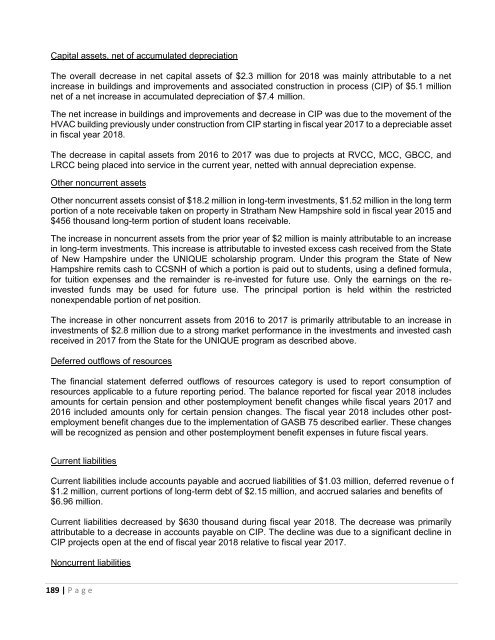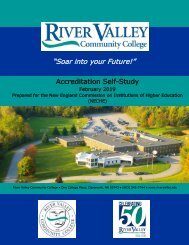Create successful ePaper yourself
Turn your PDF publications into a flip-book with our unique Google optimized e-Paper software.
Capital assets, net of accumulated depreciation<br />
The overall decrease in net capital assets of $2.3 million for 2018 was mainly attributable to a net<br />
increase in buildings and improvements and associated construction in process (CIP) of $5.1 million<br />
net of a net increase in accumulated depreciation of $7.4 million.<br />
The net increase in buildings and improvements and decrease in CIP was due to the movement of the<br />
HVAC building previously under construction from CIP starting in fiscal year 2017 to a depreciable asset<br />
in fiscal year 2018.<br />
The decrease in capital assets from 2016 to 2017 was due to projects at <strong>RVCC</strong>, MCC, GBCC, and<br />
LRCC being placed into service in the current year, netted with annual depreciation expense.<br />
Other noncurrent assets<br />
Other noncurrent assets consist of $18.2 million in long-term investments, $1.52 million in the long term<br />
portion of a note receivable taken on property in Stratham New Hampshire sold in fiscal year 2015 and<br />
$456 thousand long-term portion of student loans receivable.<br />
The increase in noncurrent assets from the prior year of $2 million is mainly attributable to an increase<br />
in long-term investments. This increase is attributable to invested excess cash received from the State<br />
of New Hampshire under the UNIQUE scholarship program. Under this program the State of New<br />
Hampshire remits cash to CCSNH of which a portion is paid out to students, using a defined formula,<br />
for tuition expenses and the remainder is re-invested for future use. Only the earnings on the reinvested<br />
funds may be used for future use. The principal portion is held within the restricted<br />
nonexpendable portion of net position.<br />
The increase in other noncurrent assets from 2016 to 2017 is primarily attributable to an increase in<br />
investments of $2.8 million due to a strong market performance in the investments and invested cash<br />
received in 2017 from the State for the UNIQUE program as described above.<br />
Deferred outflows of resources<br />
The financial statement deferred outflows of resources category is used to report consumption of<br />
resources applicable to a future reporting period. The balance reported for fiscal year 2018 includes<br />
amounts for certain pension and other postemployment benefit changes while fiscal years 2017 and<br />
2016 included amounts only for certain pension changes. The fiscal year 2018 includes other postemployment<br />
benefit changes due to the implementation of GASB 75 described earlier. These changes<br />
will be recognized as pension and other postemployment benefit expenses in future fiscal years.<br />
Current liabilities<br />
Current liabilities include accounts payable and accrued liabilities of $1.03 million, deferred revenue o f<br />
$1.2 million, current portions of long-term debt of $2.15 million, and accrued salaries and benefits of<br />
$6.96 million.<br />
Current liabilities decreased by $630 thousand during fiscal year 2018. The decrease was primarily<br />
attributable to a decrease in accounts payable on CIP. The decline was due to a significant decline in<br />
CIP projects open at the end of fiscal year 2018 relative to fiscal year 2017.<br />
Noncurrent liabilities<br />
189 | P a g e





